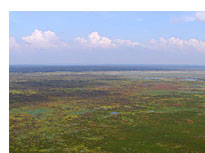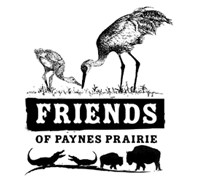Natural Features | Cultural Heritage | Preserve Management | Recreation
Many people sharing a great affinity for the vast green plain.
Archie Carr wrote of Paynes Prairie:
"There is no telling the things you see on the Prairie. The sun rises at one end and sets at the
other. To a taste not too dependent upon towns, there is always something, if only a new set
of shades in the grass and sky or a round-tail muskrat bouncing across the blacktop, or a
string of teal running low with the clouds in the twilight in front of the winter wind. The
Prairie is a solid thing to hold to in a world all broken out with man. There is peace out
there, and quiet to hear the rails call, and the cranes bugling in the sky." (Carr 1964:162)
Diversity
Located in a sinkhole-rich region of North Florida, Paynes Prairie is composed of 25 diverse natural communities. Its rolling terrain rangesin elevation from 150 feet in the uplands to
less than 50 feet at Alachua Sink. The prairie's shallow basin is close to 14,000 acres of wetland. A mosaic of wet prairie, freshwater marsh and
open water covers the basin, which was formed through the dissolution of the underlying limestone and subsequent settling of the
terrain.  Seasonally, dazzling displays of marsh marigolds, American lotus and pickerelweed paint the landscape.
During its recorded history, the basin's character has changed little, except for brief periods when the area has flooded enough
to be considered a lake. Surrounding uplands include mixed deciduous forest, pine flatwoods, swamps, old fields, scrub and ponds.
Seasonally, dazzling displays of marsh marigolds, American lotus and pickerelweed paint the landscape.
During its recorded history, the basin's character has changed little, except for brief periods when the area has flooded enough
to be considered a lake. Surrounding uplands include mixed deciduous forest, pine flatwoods, swamps, old fields, scrub and ponds.
Wildlife viewing opportunites abound! Also see:
Plant List, Bird List, and the Vertebrate List.
Climate
The climate of northcentral Florida is characterized by hot, humid summers and mild, dry winters. The annual precipitation is 53.98 in. (1370mm) of which greater than 50% occurs between June and September. Summer precipitation is in the form of afternoon thunder showers while precipitation during the winter it is associated with the passage of cold fronts. Surface water levels fluctuate seasonally with higher water occurring in March and April and again in July and August.
Geology and Physiography
Paynes Prairie Preserve State Park is situated in the central highlands of Florida. In the vicinity of the Prairie the central highlands are characterized by flat-bottom lakes, wet prairies and the erosional remnants of a plateau that extends to the north.  The bedrock underlying the Preserve is composed of limestone and dolomite bedded in horizontal layers at or near the earth's surface. Groundwater has dissolved the bedrock creating a karst topography. Surface and sub-surface features in the region include irregular drainage patterns, disappearing streams, caves, sinkholes, seepage springs, artesian wells, and natural bridges. Paynes Prairie is an excellent example of a large solution feature. The bottom of Paynes Prairie is at the long term level of the local aquifer and all surface water flow out of the basin is through a sinkhole located along the north rim of the basin.
The bedrock underlying the Preserve is composed of limestone and dolomite bedded in horizontal layers at or near the earth's surface. Groundwater has dissolved the bedrock creating a karst topography. Surface and sub-surface features in the region include irregular drainage patterns, disappearing streams, caves, sinkholes, seepage springs, artesian wells, and natural bridges. Paynes Prairie is an excellent example of a large solution feature. The bottom of Paynes Prairie is at the long term level of the local aquifer and all surface water flow out of the basin is through a sinkhole located along the north rim of the basin.





 Seasonally, dazzling displays of marsh marigolds, American lotus and pickerelweed paint the landscape.
During its recorded history, the basin's character has changed little, except for brief periods when the area has flooded enough
to be considered a lake. Surrounding uplands include mixed deciduous forest, pine flatwoods, swamps, old fields, scrub and ponds.
Seasonally, dazzling displays of marsh marigolds, American lotus and pickerelweed paint the landscape.
During its recorded history, the basin's character has changed little, except for brief periods when the area has flooded enough
to be considered a lake. Surrounding uplands include mixed deciduous forest, pine flatwoods, swamps, old fields, scrub and ponds. The bedrock underlying the Preserve is composed of limestone and dolomite bedded in horizontal layers at or near the earth's surface. Groundwater has dissolved the bedrock creating a karst topography. Surface and sub-surface features in the region include irregular drainage patterns, disappearing streams, caves, sinkholes, seepage springs, artesian wells, and natural bridges. Paynes Prairie is an excellent example of a large solution feature. The bottom of Paynes Prairie is at the long term level of the local aquifer and all surface water flow out of the basin is through a sinkhole located along the north rim of the basin.
The bedrock underlying the Preserve is composed of limestone and dolomite bedded in horizontal layers at or near the earth's surface. Groundwater has dissolved the bedrock creating a karst topography. Surface and sub-surface features in the region include irregular drainage patterns, disappearing streams, caves, sinkholes, seepage springs, artesian wells, and natural bridges. Paynes Prairie is an excellent example of a large solution feature. The bottom of Paynes Prairie is at the long term level of the local aquifer and all surface water flow out of the basin is through a sinkhole located along the north rim of the basin.